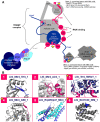ELM-the Eukaryotic Linear Motif resource-2024 update
- PMID: 37962385
- PMCID: PMC10767929
- DOI: 10.1093/nar/gkad1058
ELM-the Eukaryotic Linear Motif resource-2024 update
Abstract
Short Linear Motifs (SLiMs) are the smallest structural and functional components of modular eukaryotic proteins. They are also the most abundant, especially when considering post-translational modifications. As well as being found throughout the cell as part of regulatory processes, SLiMs are extensively mimicked by intracellular pathogens. At the heart of the Eukaryotic Linear Motif (ELM) Resource is a representative (not comprehensive) database. The ELM entries are created by a growing community of skilled annotators and provide an introduction to linear motif functionality for biomedical researchers. The 2024 ELM update includes 346 novel motif instances in areas ranging from innate immunity to both protein and RNA degradation systems. In total, 39 classes of newly annotated motifs have been added, and another 17 existing entries have been updated in the database. The 2024 ELM release now includes 356 motif classes incorporating 4283 individual motif instances manually curated from 4274 scientific publications and including >700 links to experimentally determined 3D structures. In a recent development, the InterPro protein module resource now also includes ELM data. ELM is available at: http://elm.eu.org.
© The Author(s) 2023. Published by Oxford University Press on behalf of Nucleic Acids Research.
Figures





References
MeSH terms
Substances
Grants and funding
LinkOut - more resources
Full Text Sources
Other Literature Sources
Research Materials

